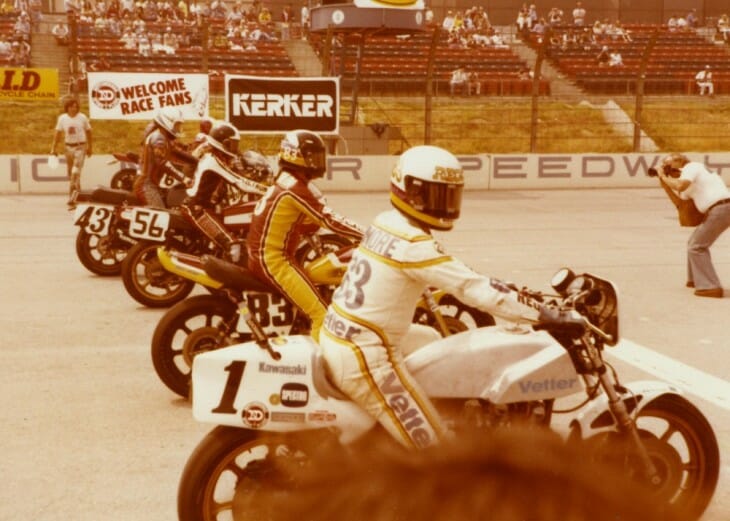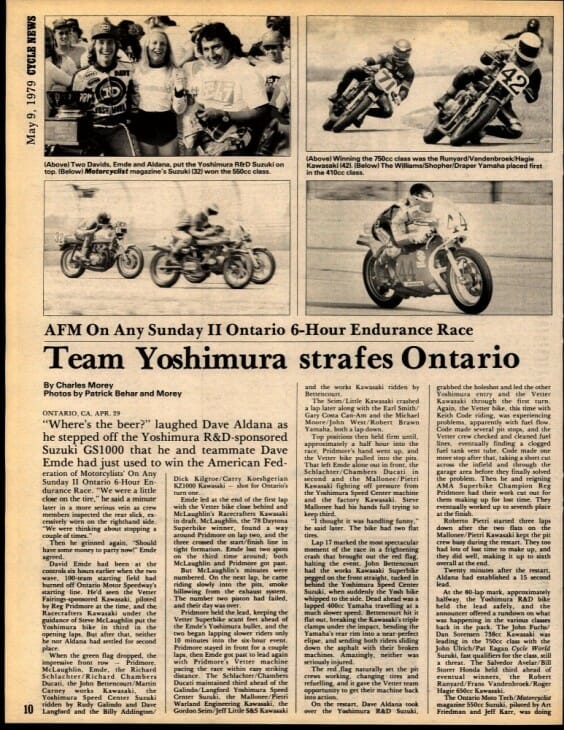Larry Lawrence | May 18, 2016

Heavy hitters: The front row for the 1979 AFM Six-Hour from Ontario Motor Speedway – Reg Pridmore (1), Steve McLaughlin (83), David Emde (56) and Mike Baldwin (43). (Don Emde Collection)
Outside of AMA Road Race Nationals, probably the most important road race in America during the 1970s was the American Federation of Motorcyclists (AFM) Six-Hour. The AFM’s Six-Hour endurance race brought together some of the top AMA road racing stars and very often factory entries. You could say it was America’s version of the Suzuka Eight-Hour. The race helped launch Superbike racing in America and then later hosted some of AMA Superbike’s elite teams.
The genesis of the AFM Six-Hour was the AFM 300, a 300-mile production race held at Ontario Motor Speedway in 1974. That 300 miler drew a very strong field of team from the start and served as a solid foundation for the expansion of the race into a Six-Hour endurance race. The father and son team of Buddy and Mike Parriott won the 1974 AFM 300 aboard a Yoshimura Kawasaki. The field in ’74 included Yvon Duhamel and Dale Alexander on another Yoshimura Kawasaki; Butler and Smith BMW Superbikes ridden by Reg Pridmore and Marty Lunde on one BMW and Art Baumann and Ron Pierce on another. Pretty heavy hitters for a club endurance event and the field would only grow stronger in the coming years as the race morphed into the Six-Hour.
The Six-Hour started in earnest in 1975 at Ontario and again boasted a talent-packed field of riders. There was David Aldana and Mike Parriott on a Kawasaki Z-1; Bob Endicott and Pat Evans on another Z-1; soon to be AMA Superbike stars Reg Pridmore and Cook Neilson on a BMW and Team Hansen’s Lane Weil and Keith Code on blazingly fast Laverda SF750. A lot could happen in six hours and most of it did to almost all the top teams that year. In the end Martin Carney and Roger Hagie, on an absolutely stock Z-1 with Dunlop F6B and K87 tires, fast and steady throughout, won the first AFM Six-Hour. It was a good thing the race wasn’t any longer. Carney and Hagie noticed after the race that their Z-1 had no oil showing in the crankcase glass.

Maybe the biggest upset in AFM Six-Hour came at Ontario in 1976 when underdogs Dave Breetwor and Steve Malonee took a totally unexpected overall victory on their Mr. Jags Triumph 750, built by Steve Peterman. Peterman also built a 1000cc Triumph Trident for Dick Fuller and Jim Haberlin for the race. Fuller and Haberlin were fast all day and led, when, with just a half-hour to go, the Trident split a cylinder and dropped out.
Peterman later admitted he was amazed the Trident lasted that long. “I brought the 1000cc to see what would break,” Peterman explained. “I didn’t think it would last an hour, but it lasted five-and-a-half hours. Just wait until Laguna Seca,” he continued, speaking of the upcoming AMA Superbike race.
The breakdown of Peterman’s Trident produced the quote of the weekend when Fuller said, “It was an easy bike to ride, but a hard bike to push.”
The ’77 race grew even larger with 82 bikes in that year’s field. A total of 45 teams finished. Interestingly, it was the ’77 Six-Hour that may have caused ’76 AMA Superbike Champion Reg Pridmore to switch from BMW to Kawasaki. Pridmore accepted an invitation to race the Six-Hour on the Racecrafters Kawasaki KZ1000 and was instantly fast. Butler and Smith BMW was wavering on its support of the Superbike series, so Pridemore, bolstered by the Six-Hour ride made the move to the Racecrafters squad.
The ’77 edition of the Six-Hour was also notable in that Paul Ritter (who would go on to win the Sears Point AMA Superbike race later that summer) and his racing partner Vance Breese got outstanding gas mileage from their Ducati 750S and went 90 minutes between pit stops (most other team could only go an hour at a time).
Wes Cooley and Tony Murphy won the ’77 Six-Hour on a Yoshimura Kawasaki Z1 over Harry Klinzmann and David Emde on another Z-1. The results were not made official that year until the Monday after the race. The races were scored by team’s supplying individual scorers watching a clock and their team and marking a time sheet every time their team came around each lap. Problems would crop up if a scorer missed a lap, not hard to do, especially considering Cooley and Murphy ran 153 laps that year. Keeping scoring straight was always a challenge and the ’77 race would not be the last time the issue caused complications with the final results.
An indication of just how important the AFM Six-Hour had become was pointed out by Paul Ritter in a story he wrote about the race. “In 1978 there were 101 entries and 95 starting teams. The event always drew some top-flight talent. In 1977, for example, the 9 riders who comprised the top four finishing teams included no fewer than 5 AMA Superbike race winners.”
Daylong rain is rare in Southern California, but that’s just what the riders faced in the 1978 AFM Six-Hour. A huge field started the race that year and in the end it was Reg Pridmore, Keith Code and Pierre desRoches winning on the Vetter Kawasaki KZ1000. Pridmore was the hero of the race, chasing down and passing the team of Hurley Wilvert and Dennis David in the closing laps to give Vetter Kawasaki the victory.
Notably in the ’78 race Billy Addington led the first lap on a turbo-charged Suzuki GS1000!
The race really exploded in popularity by 1979. That year it featured a $10,000 purse and even warranted a race preview in Cycle News.
The very experienced team of Dave Emde and David Aldana scored victory in the 1979 AFM Six-Hour. The pair rode a Yoshimura Suzuki GS1000. That year’s race had a potentially catastrophic crash. John Bettencourt had the factory Kawasaki Superbike at full song coming down front straight. Johnny B was drafting behind the Yoshimura Suzuki and when the Yosh bike moved over to avoid a slower bike, dead ahead for Bettencourt was a Yamaha RD400 going 40 mph slower. The factory Kawasaki smashed the backend of the little Yamaha and both riders went sliding down the front straight. The crash brought out the red flag, but miraculously neither rider was seriously injured.
The 1980 Six-Hour was perhaps the zenith of the event. It pitted Freddie Spencer and Ron Pierce on a factory Honda CB750F-based Superbike, against the Team Kawasaki’s David Aldana and Eddie Lawson and the Yoshimura Suzuki of Wes Cooley and Rich Schlachter – basically a full-on team AMA Superbike race.
The race ended in controversy with Team Honda and Team Kawasaki running neck and neck for the win. Protests were issued and a week after the race Honda’s Spencer and Pierce were credited with the win, while it appeared that Lawson and Aldana may have actually won the race on the Kawasaki, but lost out due to an inexperienced scorer, who missed laps and failed to immediately alert AFM officials.
The controversy of the 1980 and race the closure of Ontario Motor Speedway, took the air out of the AFM Six-Hour balloon. The race went on for a few more good years at Riverside. Lawson and Pierce avenged Kawasaki’s loss, by winning the ’81 race at Riverside, but after that the factory teams were gone and the race eventually faded.
For a time in the late 1970s and into the early ‘80s the AFM Six-Hour became one of the biggest road races in America, perhaps second in importance to the Daytona 200.